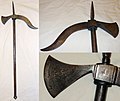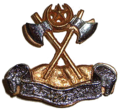Tabar (axe)

The tabar (also called tabarzin, which means "saddle axe" [in persian], Persian: تبر) is a type of battle axe. The term tabar is used for axes originating from the Ottoman Empire, Persia, India and surrounding countries and cultures. As a loanword taken through Iranian Scythian, the word tabar is also used in most Slavic languages as the word for axe[1] (e.g. Russian: топор).
Persia
The tabarzin (saddle axe) (
India
During the 17th and 18th centuries, the tabar battle axe was a standard weapon of the mounted warriors of Punjab, Sikh Khalsa army and what is now modern day India and Pakistan. Made entirely of metal or with a wood haft, it had a strongly curved blade and a hammer-headed poll and was often decorated with scroll work. Sometimes a small knife was inserted in the tabar's hollow haft.
Arabia
According to Adam Metz's "Islamic Civilization in the Fourth Century of the Hegira," the tabar was frequently not only a weapon used by police chiefs (Sahib al-Shurta), but also a mark of office for them.
Gallery
-
Indian (Southern) tabar (axe), 18th century, the wooden haft has a steel tang running 3/4 of the way down, pinned by four rivets. The axe head is brass with a forged steel blade, L. 58 cm.
-
Indian tabar-zaghnal, a combination tabar axe and zaghnal war hammer - pick, all-steel construction, 18th to 19th century
-
Indian (Deccan) tabar-shishpar, an extremely rare combination tabar axe and shishpar eight-flanged mace, steel with hollow shaft, 21.75 inches, 17th to 18th century
-
18th century Indo-Persian ceremonial tabar, crafted of steel with gold koftgari inlay, Kufic calligraphy and pierced decorations
-
Flag ofSindhudeshmovement, the axe represents anger against enemies.
-
Badge of Sindh Regiment an infantry regiment in Pakistan army.
See also
References
- ^ ISBN 978-5-01-001154-3.
- ^ Complete Persian culture (Dary dialect) by Gholam-reza Ensaf-pur
- ^ Bailey, H. W. (December 15, 1986). "ARMENIA AND IRAN iv. Iranian influences". Encyclopaedia Iranica. Vol. II, Fasc. 4-5. pp. 445–465.
- ISBN 978-0-19-538707-0.
- ^ Sussex & Cubberley (2011, pp. 111–112)
Sources
- ISBN 978-0-521-29448-5





